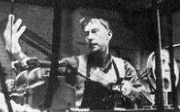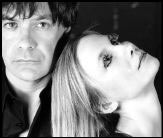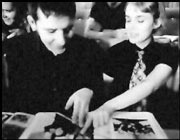VISUAL MUSIC FESTIVAL 2002
runs March 20-April 3 at Little Theatre and Experience Music Project
MULTIMEDIA presentations—particularly those that marry film and music—are now so ingrained in mass culture that a festival celebrating “visual music” may seem like a rather superfluous enterprise. As curator Peter Lucas concedes, visual music, from “MTV and its vast domain, multimedia concerts, TV commercials . . . even the ubiquitous laser light shows and Super Bowl halftime extravaganzas,” is practically inescapable.
Thankfully, this two-week series transcends such audio-visual clutter by emphasizing experimental works and conducting special events, including a filmmaking workshop, a night of local Super-8 movies (8 p.m. Thurs., March 21, Little Theatre), and a live opening-night extravaganza featuring Sonic Youth’s Lee Ranaldo accompanying the films of Leah Singer (8 p.m. Wed., March 20, EMP). What most merits celebration, though, is the fest’s historical focus on the underlying craft and its cultural relevance.
The earliest and perhaps most revelatory movies here belong to New Zealand artist Len Lye (1901-1980). Lye pioneered “direct animation”—drawing, scratching, and applying color directly to the film strip—in the mid-’30s with innovative shorts that put modern art into motion. Geometric patterns provide the bulk of Lye’s visuals, but the stenciled lettering used in efforts like 1935’s Kaleidoscope—which incorporates an ad for Churchman’s cigarettes—helped establish him as an early practitioner of pop art. (Lye’s works are showcased at 7 and 9 p.m. Sat., March 30, Little Theatre.)
Another festival highlight is its collection of abstract films from the Beat era. As performers like Dizzy Gillespie and Thelonius Monk took jazz into more adventuresome, less commercial turf, Lye and other visual artists of the ’50s flocked to follow the new sound. Several films on display were originally projected as backdrops at jazz clubs; others were essentially designed to fit the music. Technical advances of the era allowed the creation of highly kinetic collages attuned to the improvisational nature of jazz. Multispeed projectors permitted closer synchronization of sound and image, while Hy Hirsh actually resorted to an oscilloscope—you know, those cathode-ray-tube things that display electrical frequencies—for the groundbreak- ing Ereni (1953).
Subsequent technical advances— namely the growth of all things digital—have yielded even more elaborate experiments. (Recent works are featured at 7 and 9 p.m. Sun., March 31, Little Theatre.) To judge from the festival’s preview reel, these newer titles haven’t necessarily surpassed the Beat-era symbiosis of image and music, but they’re no less interesting examples of an overlooked art.








